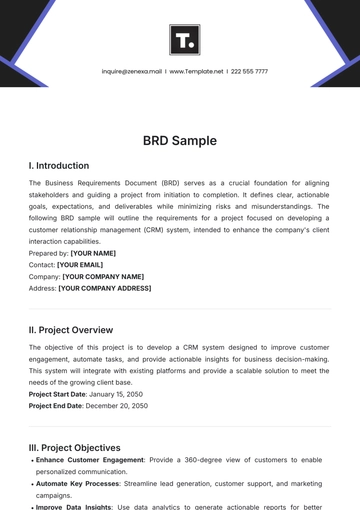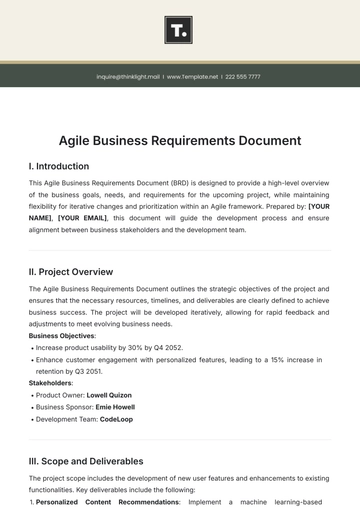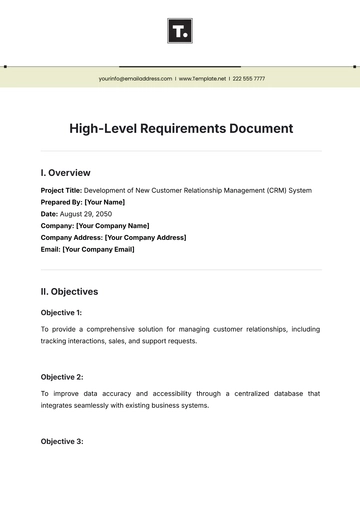Business Requirements Document
I. Introduction
This Business Requirements Document (BRD) serves as a foundational reference for all stakeholders, ensuring alignment in project goals and guiding the development of solutions to meet business requirements. The goal is to improve customer management processes, enhance data tracking, and streamline workflows across departments.
II. Project Overview
The CRM System Upgrade aims to modernize the organization’s customer management processes by integrating new features and improving system performance. The project will address business needs such as enhanced customer data tracking, improved reporting capabilities, and more efficient workflows for the sales and customer support teams. This initiative will help boost customer satisfaction, drive sales, and optimize internal operations.
Prepared by: [YOUR NAME]
Email: [YOUR EMAIL]
Company Name: [YOUR COMPANY NAME]
Company Address: [YOUR COMPANY ADDRESS]
III. Business Objectives
The primary objectives of the CRM System Upgrade are as follows:
Objective 1: Improve customer data tracking and reporting to enhance sales strategies and decision-making.
Objective 2: Automate sales processes to increase efficiency and reduce manual errors.
Objective 3: Enhance customer support capabilities to ensure faster resolution of queries and issues.
These objectives will be achieved by implementing a state-of-the-art CRM system that integrates seamlessly with existing tools and supports new features such as predictive analytics and automated reminders.
IV. Scope of the Project
The project will include the following activities:
Activity 1: CRM system upgrade and configuration to meet business needs.
Activity 2: Data migration from the legacy CRM to the new platform, ensuring no loss of customer information.
Activity 3: User training and adoption to ensure smooth transition to the new system.
Exclusions:
Development of any features not related to CRM functionality (e.g., non-sales tools).
Integration with systems not already in use (e.g., new marketing platforms outside of the CRM).
The project will be executed within the established timeline and constraints.
V. Stakeholder Requirements
The following stakeholders have defined requirements that the project must meet:
Stakeholder | Requirement/Need | Priority | Deadline | Responsible Party |
|---|
Sales Manager | Ability to track customer interactions and sales forecasts | High | January 15, 2050 | Lyda Fadel |
Customer Support | Improved ticket resolution capabilities | Medium | February 22, 2050 | Johann Harvey |
Marketing Director | Enhanced lead tracking and campaign performance | Low | March 10, 2050 | Sigmund Corwin |
VI. Functional Requirements
The following functional requirements have been identified for the project:
Requirement 1: The CRM system must integrate with existing email and marketing platforms to track leads and customer interactions.
Requirement 2: The system must allow for custom reporting based on customer demographics, sales activity, and support history.
Requirement 3: The CRM should include automated task reminders for sales follow-ups, customer service queries, and appointments.
VII. Project Timeline
The project will follow the timeline below:
Task/Phase | Start Date | End Date | Responsible Party | Comments |
|---|
Initial Planning | January 5, 2050 | January 15, 2050 | Project Manager | Define project scope |
Requirement Gathering | January 16, 2050 | February 15, 2050 | Business Analyst | Gather stakeholder input |
Design Phase | February 16, 2050 | March 5, 2050 | System Architect | CRM design finalization |
Implementation | March 6, 2050 | May 30, 2050 | Development Team | System coding & testing |
Go Live | June 1, 2050 | June 1, 2050 | Project Manager | System launch |
VIII. Budget and Resources
The estimated budget for this project is as follows:
Category | Estimated Cost | Notes |
|---|
Personnel Costs | $200,000 | Developers, project manager, BA |
Technology/Tools | $150,000 | CRM software, integration tools |
Miscellaneous | $50,000 | Training materials, contingency |
The resources required include CRM software licenses, data migration tools, development environments, and a dedicated team of 10 people for the duration of the project.
IX. Conclusion
The successful implementation of the CRM System Upgrade will provide significant benefits to the organization, including improved sales efficiency, enhanced customer tracking, and a better user experience for both customers and internal teams. By aligning all stakeholders on the requirements and timelines outlined in this document, the project will proceed smoothly, ensuring that all objectives are met on time and within budget.
Business Requirements Document Templates @ Template.net






























